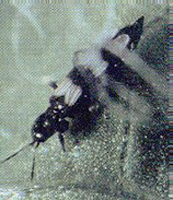|
|
Back to Pest Identification and Diagnosis
BANDED GREENHOUSE THRIPS
SCIENTIFIC NAME: Hercinothrips femoralis (O.M. Reuter)
CLASS: Insecta
ORDER: Thysanoptera
FAMILY: Thripidae
 |
 A. Adult B. Eggs C-D. Larvae E. Prepupa F. Pupa |
|
|
Banded Greenhouse Thrips From: University of California |
Life Cycle From: NC Extension |
| DESCRIPTION | |
|
Adults: Female banded greenhouse thrips, approximately 1.5 mm long, are primarily yellow at first but gradually darken to brown or black. The eyes are red; the narrow, fringed wings are gray brown with 3 white crossbands. Males are rare. Eggs: When first deposited, the translucent elongate eggs are white 0.25 mm in length. Before hatching, each eggs wells and becomes dull white. Larvae: The yellow or white larvae vary from 0.48 to 1.5 mm in length. They are wingless and have red eyes. Pupae and Prepupae: These stages are white and found on the leaves. There are usually more individuals on the lower surface. |
|
| BIOLOGY | |
|
Distribution: Although sporadically distributed through out North America, banded greenhouse thrips are widely distributed throughout the world. They are particularly common in the British Isles, Europe, and East Africa. Host Plants: In the greenhouse, banded greenhouse thrips attack many crops including cucumbers, begonias, cacti, date palm, bananas, callas, cestrum, amaryllis, aralia, chrysanthemum, dracaena, rubber tree, gardenia, croton, hydrangea, moon flower, schefflera, screw pine, tomato, and Mexican tea. In one experiment in Georgia, 44 species of plants were used as host plants out of 50 presented. The banded green house thrips showed definite preference for some species among those accepted as host plants. Damage: Banded greenhouse thrips pierce plant tissues with their mouthparts and suck the juices. As a result, irregular white spots form on the leaf giving it an overall silver appearance. Eventually, these areas dry out and turn light brown. Some defoliation results. Life Cycle: The banded greenhouse thrips, sometimes referred to as the sugar beet thrips, has gained notoriety as a major floricultural pest. In North Carolina, this thrips was first reported as a greenhouse pest in 1943 on white callas. In the greenhouse, thrips may breed continuously and have several generations per year. Eggs are deposited on the underside of leaves or along the stem. Approximately 2 weeks later, larvae emerge and begin feeding. Colonies of young larvae congregate on the underside of leaves and individuals are often covered with a watery globule of excrement. As the larvae feed, they develop through four instars, molting between each stage. The more mature larvae are typically found along leaf midribs or among dried-up foliage. After a larval stage of approximately 18 days, banded greenhouse thrips pupate. Adult thrips that emerge shortly thereafter are less voracious feeders than the larvae. Adults live 40 or more days and females may reproduce with or without mating. Males of this species are rarely found. |
|
| CONTROL | |
|
Banded greenhouse thrips are vulnerable to contact insecticides. Stored bulbs can be dusted with such an insecticide to prevent a thrips infestation on plants the following season. |
Back to Pest Identification and Diagnosis
 |
(C) Regents of the University of
Minnesota. All rights reserved. |
 |
 |